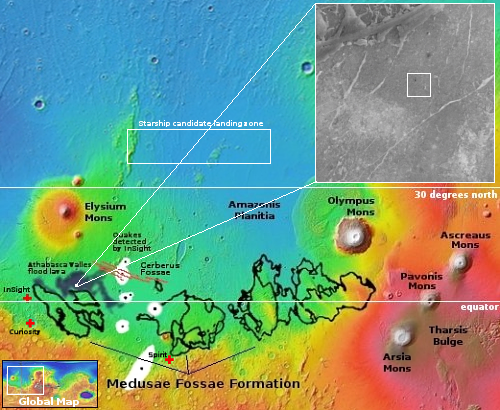Small fresh impact on Mars’ youngest major lava flow
Cool image time! The picture to the right, cropped, reduced, and sharpened to post here, was taken on August 26, 2025 by the high resolution camera on Mars Reconnaissance Orbiter (MRO).
The camera team labels this “Monitoring New Impact Site.” The fresh impact, indicated by the three dark patches just left and up from center, is actually not that fresh. It was first photographed by MRO on September 27, 2008. This newer picture is to see if anything significant had changed in the subsequent seventeen years.
In comparing the two pictures, the only change that is obvious is that the patches have faded and become less distinct. Nothing else appears different.
The surrounding terrain however is interesting in its own right. The landscape is remarkably flat, though it has that meandering ridge coming out from that lighter patch in the lower right. What are we looking at?

The white dot on the overview map to the right marks the location, deep within the Athabasca flood lava in the dry Martian tropics. Athabasca is considered the most recent major volcanic flood event on Mars, having occurred about 600 million years ago, when it covered an area about the size of Great Britain in only a matter of weeks.
When that flood lava hardened, it did so almost like ice floes in the Arctic. The lighter patches appear to be places where the floes moved as they solidified, revealing a lighter layer below. That freezing process also likely created the meandering ridge, which was likely a small stream of lava flowing down from that lighter patch that later hardened.
This region is filled with similar floes and openings, as shown in the inset, suggesting as the flood lava pushed forward, its crust moved with it, with pieces breaking periodically, similar to that section in the lower right of this picture.
On Christmas Eve 1968 three Americans became the first humans to visit another world. What they did to celebrate was unexpected and profound, and will be remembered throughout all human history. Genesis: the Story of Apollo 8, Robert Zimmerman's classic history of humanity's first journey to another world, tells that story, and it is now available as both an ebook and an audiobook, both with a foreword by Valerie Anders and a new introduction by Robert Zimmerman.
The print edition can be purchased at Amazon or from any other book seller. If you want an autographed copy the price is $60 for the hardback and $45 for the paperback, plus $8 shipping for each. Go here for purchasing details. The ebook is available everywhere for $5.99 (before discount) at amazon, or direct from my ebook publisher, ebookit. If you buy it from ebookit you don't support the big tech companies and the author gets a bigger cut much sooner.
The audiobook is also available at all these vendors, and is also free with a 30-day trial membership to Audible.
"Not simply about one mission, [Genesis] is also the history of America's quest for the moon... Zimmerman has done a masterful job of tying disparate events together into a solid account of one of America's greatest human triumphs."--San Antonio Express-News
Cool image time! The picture to the right, cropped, reduced, and sharpened to post here, was taken on August 26, 2025 by the high resolution camera on Mars Reconnaissance Orbiter (MRO).
The camera team labels this “Monitoring New Impact Site.” The fresh impact, indicated by the three dark patches just left and up from center, is actually not that fresh. It was first photographed by MRO on September 27, 2008. This newer picture is to see if anything significant had changed in the subsequent seventeen years.
In comparing the two pictures, the only change that is obvious is that the patches have faded and become less distinct. Nothing else appears different.
The surrounding terrain however is interesting in its own right. The landscape is remarkably flat, though it has that meandering ridge coming out from that lighter patch in the lower right. What are we looking at?

The white dot on the overview map to the right marks the location, deep within the Athabasca flood lava in the dry Martian tropics. Athabasca is considered the most recent major volcanic flood event on Mars, having occurred about 600 million years ago, when it covered an area about the size of Great Britain in only a matter of weeks.
When that flood lava hardened, it did so almost like ice floes in the Arctic. The lighter patches appear to be places where the floes moved as they solidified, revealing a lighter layer below. That freezing process also likely created the meandering ridge, which was likely a small stream of lava flowing down from that lighter patch that later hardened.
This region is filled with similar floes and openings, as shown in the inset, suggesting as the flood lava pushed forward, its crust moved with it, with pieces breaking periodically, similar to that section in the lower right of this picture.
On Christmas Eve 1968 three Americans became the first humans to visit another world. What they did to celebrate was unexpected and profound, and will be remembered throughout all human history. Genesis: the Story of Apollo 8, Robert Zimmerman's classic history of humanity's first journey to another world, tells that story, and it is now available as both an ebook and an audiobook, both with a foreword by Valerie Anders and a new introduction by Robert Zimmerman.
The print edition can be purchased at Amazon or from any other book seller. If you want an autographed copy the price is $60 for the hardback and $45 for the paperback, plus $8 shipping for each. Go here for purchasing details. The ebook is available everywhere for $5.99 (before discount) at amazon, or direct from my ebook publisher, ebookit. If you buy it from ebookit you don't support the big tech companies and the author gets a bigger cut much sooner.
The audiobook is also available at all these vendors, and is also free with a 30-day trial membership to Audible.
"Not simply about one mission, [Genesis] is also the history of America's quest for the moon... Zimmerman has done a masterful job of tying disparate events together into a solid account of one of America's greatest human triumphs."--San Antonio Express-News


